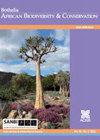Anatomia e histoquímica do caule de espécies conhecidas como quebra-pedra das famílias Euphorbiaceae e Phyllanthaceae
IF 0.5
4区 生物学
Q4 PLANT SCIENCES
引用次数: 0
Abstract
This study aimed to provide structural and histochemical information about the stem of species popularly known as “stone breaker”, found in the municipality of São Mateus (ES). The species analyzed were Euphorbia prostrata Aiton., Euphorbia hyssopifolia L., Phyllanthus amarus Schumach. & Thonn and Phyllanthus tenellus Roxb. Vouchers were collected on the Campus of the Federal University of Espirito Santo and in the Sernamby neighborhood. For the analysis, cross sections were performed between the 2nd and 5th nodes, to describe the primary growth, and between the 9th and 10th nodes, for secondary growth. Tests were carried out to detect starch, chemical composition of crystals, total lipids, latex, non-structural phenolic compounds and lignin. As for anatomical analyzes, only E. prostrata presented trichomes, which are of the tector type. Only in the species of Phyllanthus crystals were observed. Euphorbia species are differentiated by the presence of laticiferous channels. Histochemical tests revealed accumulation of starch grains, showing the amyliferous sheath of P. amarus and phenolic compounds only in the epidermis of E. prostrata. Anatomical and histochemical studies are of great relevance for the knowledge and differentiation of the species known as stone breakers, and may assist in the identification of other species with the same popular name.大戟科和叶蕨科植物的茎的解剖和组织化学
本研究旨在提供在奥马特乌斯(ES)市发现的俗称为“碎石者”的物种茎的结构和组织化学信息。分析种为大戟(Euphorbia prostrata Aiton)。大戟、大戟、毛兰。&毛茛和毛茛。代金券是在圣埃斯皮里图联邦大学校园和塞尔南比社区收集的。为了进行分析,在第2和第5节之间进行了横断面,以描述初生生长,在第9和第10节之间进行了二次生长。对淀粉、晶体化学成分、总脂、乳胶、非结构酚类化合物和木质素进行了检测。在解剖分析上,只有prostrata有毛状体,属于触须型。只在余甘子属中观察到结晶。大戟的种类是通过乳汁通道的存在来区分的。组织化学测试显示淀粉颗粒的积累,显示出amarus的淀粉鞘和酚类化合物仅存在于prostrata的表皮。解剖和组织化学研究对于了解和区分被称为碎石虫的物种具有重要意义,并可能有助于识别具有相同流行名称的其他物种。
本文章由计算机程序翻译,如有差异,请以英文原文为准。
求助全文
约1分钟内获得全文
求助全文
来源期刊

Bothalia
生物-植物科学
CiteScore
1.70
自引率
0.00%
发文量
12
期刊介绍:
Bothalia: African Biodiversity & Conservation is published by AOSIS for the South African National Biodiversity Institute (SANBI) and aims to disseminate knowledge, information and innovative approaches that promote and enhance the wise use and management of biodiversity in order to sustain the systems and species that support and benefit the people of Africa.
The journal was previously published as Bothalia, and had served the South African botanical community since 1921. However the expanded mandate of SANBI necessitated a broader scope for the journal, and in 2014, the subtitle, African Biodiversity & Conservation was added to reflect this change.
 求助内容:
求助内容: 应助结果提醒方式:
应助结果提醒方式:


